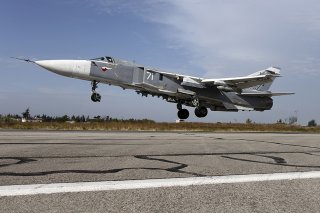Su-27 Fighters, Bombers and More: Russia's Military Conducts More Northern Exercises
During the aviation drills, the crews from the Baltic Fleet launched airborne missiles and rockets of various classes, fired aircraft guns and dropped bombs weighing from one hundred to five hundred kilograms.
This summer Russia has experienced quite a heatwave, and Moscow even broke a 128-year heat record in July, but for many Russian military personnel, it has probably been more about keeping warm than beating the heat. This week the Russian Baltic Fleet kicked off aviation drills in the westernmost Kaliningrad region, while troops from the Russian Northern Fleet took part in tactical exercises on the Taimyr Peninsula.
During the aviation drills, the crews from the Baltic Fleet launched airborne missiles and rockets of various classes, fired aircraft guns and dropped bombs weighing from one hundred to five hundred kilograms. The drills also included maneuvering elements in an aerial battle as well as target runs under a notional enemy’s jamming.
“During scheduled drills, over 20 crews of Su-27, Su-24 and Su-30SM aircraft, Mi-24 and Mi-8 attack and military-transport helicopters and also of shipborne Ka-27 gunships and An-26 military-transport planes of the Baltic Fleet’s naval aviation are accomplishing a set of various assignments," the Baltic Fleet’s press office said in a statement to Tass.
Crews of the Cold War-era Su-24 frontline bomber and Su-30SM multi-role fighters dropped bombs on a target field and fired rockets against coastal targets. In addition, Sukhoi Su-27 fighters took part in the interception of notional “intruders” in the airspace over the Kaliningrad region and conducted electronic launches against enemy cruise missiles and strategic bombers. Helicopter crews also practiced missions at combat training ranges to search for and track submarines, provide air support for coastal defense troops, airlift and landed a tactical airborne assault force.
“The naval aviation pilots are accomplishing combat training tasks both in the daytime and at night,” the Baltic Fleet’s press office added. “Around 50 combat training sorties have been performed. Overall, the exercise involves about 20 aircraft and also over 400 personnel of an air formation of the Baltic Fleet’s naval aviation.”
Arctic Amphibious Assault
Russian marines from the Northern Fleet likely could have used some heat after taking part in tactical drills on the Taimyr Peninsula that included the landing of an amphibious assault force onto an unequipped shore to defend a vital industrial facility in the Arctic.
“Today tactical drills were held on the Taimyr Peninsula to practice combat operations in landing an amphibious assault force onto an unequipped shore of the Yenisei River near Dudinka,” the Northern Fleet’s press office also reported to state media. “The drills involved the crews of ships, the personnel and hardware of the army corps, a Northern Fleet marine infantry brigade and also a helicopter group that make part of the Northern Fleet’s Arctic grouping.”
During the drills, the Northern Fleet’s task force was assigned the action of recapturing a bridgehead that was “seized” by a notional terrorist force. The unit had to conduct an amphibious assault while also defending the facility. The training began with an airstrike on the enemy positions, and that was followed by fire against sheltered coastal positions from batteries of the large anti-submarine warfare (ASW) ships Kondopaga and Alexander Otrakovsky.
The Russian marines were deployed via Ka-27 helicopters to the coast. Overall, twenty combat vehicles were also deployed in the exercises and that included armored personnel carriers, snow and swamp-going vehicles and self-propelled artillery guns. The press office reported that the personnel who were involved in the landing demonstrated high combat skills and practiced the tactic of joint operations in conducting a battle as well as seizing and holding a coastal bridgehead in a qualitative way.
The Russian military has been conducting these exercises on a regular basis throughout the summer. These exercises come just days before the kick of the International Army Games 2020, which is scheduled to run from August 23 to September 5.
Peter Suciu is a Michigan-based writer who has contributed to more than four dozen magazines, newspapers and websites. He is the author of several books on military headgear including A Gallery of Military Headdress, which is available on Amazon.com.
Image: Reuters

